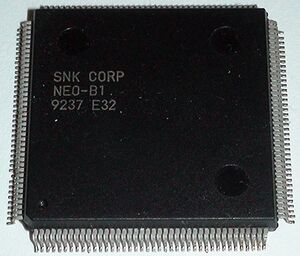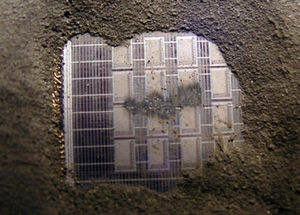NEO-B1: Difference between revisions
m (Formulation, wd details) |
mNo edit summary |
||
| Line 1: | Line 1: | ||
{{ChipInfo | |||
|picture=aes_b1.jpg | |||
|pkg=QFP160 | |||
|manu=fujitsu | |||
|date=1992 ? | |||
|gates= | |||
|used_on={{PCB|NEO-AES3-4}}... | |||
}} | |||
[[File:b1die.jpg|right|thumb|(Damaged) B1 die showing pre-built memory cells.]] | [[File:b1die.jpg|right|thumb|(Damaged) B1 die showing pre-built memory cells.]] | ||
| Line 5: | Line 12: | ||
The NEO-B1 chip is found in second generation cartridge-based systems. | The NEO-B1 chip is found in second generation cartridge-based systems. | ||
=Graphics= | |||
Both [[fix layer|fix]] graphics from the [[S ROM]] and sprite graphics from the [[C ROM]] are fed to NEO-B1 for display on screen via 2 pairs of alternating line buffers. Sprite graphics come from the C ROM multiplexer ([[NEO-ZMC2]], [[PRO-CT0]] or [[NEO-CMC]]), while fix graphics come directly from the currently enabled fix ROM. | Both [[fix layer|fix]] graphics from the [[S ROM]] and sprite graphics from the [[C ROM]] are fed to NEO-B1 for display on screen via 2 pairs of alternating line buffers. Sprite graphics come from the C ROM multiplexer ([[NEO-ZMC2]], [[PRO-CT0]] or [[NEO-CMC]]), while fix graphics come directly from the currently enabled fix ROM. | ||
| Line 11: | Line 18: | ||
The chip outputs the [[palette RAM]] address to select colors for pixel output. The data output of the palette RAM is latched by a pair of 8bit registers, which in turn feed the [[video DAC]]. The NEO-B1 handles address bus switching between the [[68k]] bus and palette RAM. Priority is always given to the 68k which results in harmless display glitches when games access palette RAM during active display. | The chip outputs the [[palette RAM]] address to select colors for pixel output. The data output of the palette RAM is latched by a pair of 8bit registers, which in turn feed the [[video DAC]]. The NEO-B1 handles address bus switching between the [[68k]] bus and palette RAM. Priority is always given to the 68k which results in harmless display glitches when games access palette RAM during active display. | ||
=Watchdog= | |||
The [[watchdog]] is integrated into NEO-B1. {{Sig|HALT|HALT}} and {{Sig|RESET|RESET}} are generated by this chip on power-on and whenever the 68k fails to kick the watchdog in time. The write to {{Reg|REG_DIPSW}} is decoded on the chip instead of using a signal from [[NEO-C1]]. | The [[watchdog]] is integrated into NEO-B1. {{Sig|HALT|HALT}} and {{Sig|RESET|RESET}} are generated by this chip on power-on and whenever the 68k fails to kick the watchdog in time. The write to {{Reg|REG_DIPSW}} is decoded on the chip instead of using a signal from [[NEO-C1]]. | ||
| Line 17: | Line 24: | ||
Watchdog can be disabled by bringing pin 94 DOGE to ground (J2 jumper on main board). | Watchdog can be disabled by bringing pin 94 DOGE to ground (J2 jumper on main board). | ||
=Pinout= | |||
(Max size:[[:File:neo-b1_pinout.png]])<br> | (Max size:[[:File:neo-b1_pinout.png]])<br> | ||
| Line 23: | Line 30: | ||
OpenOffice Draw file: [[File:neo-b1.odg]] | OpenOffice Draw file: [[File:neo-b1.odg]] | ||
=Signals= | |||
*A1~A21: [[68k]] address bus | *A1~A21: [[68k]] address bus | ||
Revision as of 10:06, 30 August 2016

| |
| Package | QFP160 |
| Manufacturer | |
| First use | 1992 ? |
| Used on | NEO-AES3-4... |

The NEO-B1 chip is found in second generation cartridge-based systems.
Graphics
Both fix graphics from the S ROM and sprite graphics from the C ROM are fed to NEO-B1 for display on screen via 2 pairs of alternating line buffers. Sprite graphics come from the C ROM multiplexer (NEO-ZMC2, PRO-CT0 or NEO-CMC), while fix graphics come directly from the currently enabled fix ROM.
The chip outputs the palette RAM address to select colors for pixel output. The data output of the palette RAM is latched by a pair of 8bit registers, which in turn feed the video DAC. The NEO-B1 handles address bus switching between the 68k bus and palette RAM. Priority is always given to the 68k which results in harmless display glitches when games access palette RAM during active display.
Watchdog
The watchdog is integrated into NEO-B1. HALT and RESET are generated by this chip on power-on and whenever the 68k fails to kick the watchdog in time. The write to REG_DIPSW is decoded on the chip instead of using a signal from NEO-C1.
Watchdog can be disabled by bringing pin 94 DOGE to ground (J2 jumper on main board).
Pinout
(Max size:File:neo-b1_pinout.png)
File:Neo-b1 pinout.png
OpenOffice Draw file: File:Neo-b1.odg
Signals
- A1~A21: 68k address bus
- A22I,A23I: 68k A22,A23 passed through NEO-E0
- FIX0~FIX7: Fix ROM data bus
- PCK1/PCK2: Latch signals, shared with LSPC2-A2 (inverted for NEO-273)
- PA0~PA11: Palette RAM address bus
- TDO0~TDO11: NC on the MV1F
- GAD0~GAD3, GBD0~GBD3: Sprite pixel data (2 pixels)
- FLIP: Flip display horizontally ? Always tied to ground.
- WE1~WE4: Write enable for sprite pixels
- CK1~CK4: Stepping clocks
- SS1/SS2: ?
- LD1/LD2: Odd/Even scanline load ? Changes according to sprite list ?
- TMS0: Line buffer selection
- DOGE: Watchdog enable (internal pullup)